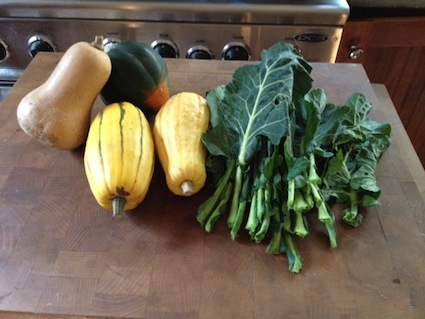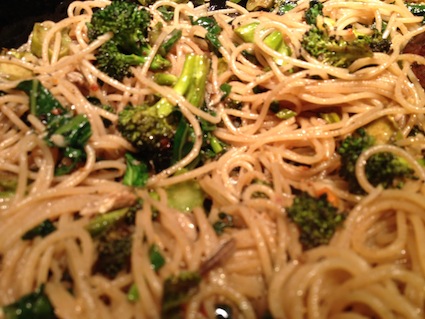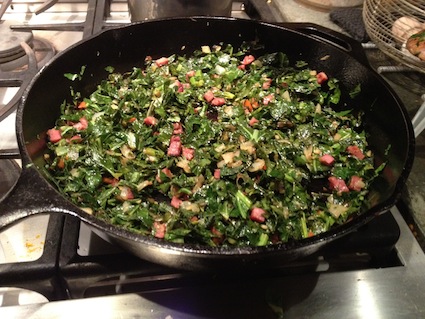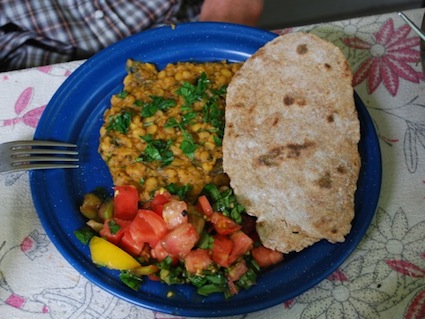
Thanksgiving is upon us; that means it’s time to spend hours in the kitchen grinding through really, really elaborate recipes.
Or not. Our national feast day is a time to enjoy food with a large table of friends and family. And for me, enjoying cooking for a crowd means keeping everything simple and low-key—leaving plenty of time to relax, hang out, and enjoy adult beverages. (Or, if you want to go dysfunctional-family-traditional, plenty of time to plunge into a snarling family meltdown … and enjoy adult beverages.)
But staying simple doesn’t mean sacrificing flavor. What I advise is to focus on getting the best ingredients you can find—and farmers markets will be brimming with great stuff this time of year—and let them speak for themselves, with just a little tweak to push them over the edge.
Here on the farm, we have a gorgeous crop of winter squashes in storage, and are still harvesting delightful hearty greens like kale and collards. I’ve been saying it for weeks now, and it’s still true: leafy greens are at their utter peak now, as morning frosts concentrates their sugars and make them sweeter.
So for our Thanksgiving table here at the farm, I decided I had to construct side dishes out of squash and greens. But, I’ve been cooking with them a lot lately. My challenge was how to make them special? I got to thinking about the traditional spices of Thanksgiving pies: cinnamon, nutmeg, ginger.
All of them are warming, and all of them are components of traditional Indian curry. Would it be too radical and jarring to drop a a spicy-curry element onto the staid Thanksgiving table? I decided that those curryesque pies have blazed a trail that gives me license to do just that with both the squash and the greens.
But I needed one more element to push the curry concept over the edge. I remembered a recipe from James Peterson’s wonderful book Vegetables, in which he has you add coconut milk to curried collards as they simmer. It adds an element of richness right for Thanksgiving, and smooths out the curry’s bite. And that’s what I’m doing this year.
Curry Mix
You can use pre-bought curry mix; but this is easy and worth the trouble. This recipe makes much more then you’ll need for these two dishes. Keep it stored in an air-tight container for later use, and grind as needed each tome—all you need is a cheap coffee grinder dedicated to spice-grinding duty. Yields about a half cup.
2 tablespoons whole cumin seeds
2 tablespoons whole cardamom seeds
2 tablespoons whole coriander seeds
1 tablespoon black mustard seeds
1 teaspoon crush chile flakes
1/8 cup ground cinnamon
1/4 cup ground turmeric
Preheat a cast-iron or other heavy-bottomed large skillet over low-medium flame. Add all ingredients except the turmeric and cinnamon to the pan; and toast, stirring occasionally, until spices become fragrant. This will just take a minute or two; don’t let them burn. Place the toasted spices along with the turmeric and cinnamon in an air-tight container, such as a 1-cup Mason jar, and shake well. The mix will keep in this state for several months—grind as needed.
Curried Roasted Squash Cubes
Serves eight.
6 cups 1/2-inch cubes peeled winter squash, such as butternut, sweet dumpling, and delicata (about 3.75 pounds total)
1 tablespoon curry mix, ground to a powder
1 teaspoon sea salt
Freshly ground black pepper
2 tablespoons of olive oil
3 cloves garlic, crushed, peeled, and minced
1 knuckle-sized chunk of fresh ginger, peeled and minced (note: ginger is easily peeled with a spoon)
1 fresh red-hot chile pepper, minced (optional)
1 nutmeg head, for grating
Preheat oven to 400. Combine the squash cubes, curry mix, olive oil, and salt in a large bowl. Give it several good grindings of black pepper, and then toss all the ingredients with your hands, making sure to coat the cubes well and evenly. Spread in one layer on a cookie sheet, and roast until tender and lightly browned, 20-30 minutes. Remove from oven, and sprinkle garlic, ginger, and (if using) chile over the cubes. Using a fine grater such as a microplane, grate a few lashings of nutmeg over the cubes. Toss using two spatulas to distribute the added spices, and return to the over for another 2-3 minutes. Taste for seasoning and serve immediately.
Curried Greens Braised with Coconut Milk
Inspired by a recipe in James Peterson’s Vegetables.
Serves eight.
1/3 cup olive oil
1 onions, cut in half and sliced thinly
3/4 teaspoon sea salt
1 tablespoon curry mix, ground
3 cloves garlic, crushed, peeled, and minced
1 knuckle-sized chunk of fresh ginger, peeled and minced
1 fresh red-hot chile pepper, minced (optional)
2.5 pounds collards and/or kale, washed, trimmed, and chopped into bite-sized pieces
3/4 teaspoon sea salt
1 tablespoon curry mix, ground
1 14 oz. can of full-fat coconut milk
1 nutmeg head, for grating
Heat olive oil over medium flame in a heavy-bottomed large pot (with a lid). Add onions. Cook, stirring occasionally, until soft and translucent. Add the salt, the ground curry, the garlic, the ginger, and (if using) the chile pepper. Stir to incorporate, and let it all sizzle together for a minute or two. Now add the greens and stir well to coat. Add the coconut milk and a half-cup of water and stir it into the greens. Turn the heat up to high until the pot begins to simmer, and then cover the the pot, turning heat to low. Cook, stirring occasionally, until the greens are tender. If the greens start looking too dry, add a little more water. When done, finish with a few grates of nutmeg; taste for salt. This dish can be made ahead a day in advance and reheated.


















